2016年3月11日托福阅读真题及答案解析
- 格式:pdf
- 大小:305.50 KB
- 文档页数:4
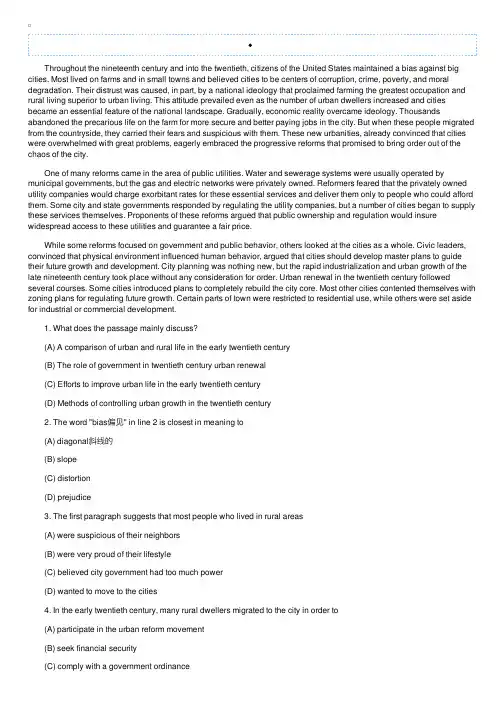
Throughout the nineteenth century and into the twentieth, citizens of the United States maintained a bias against big cities. Most lived on farms and in small towns and believed cities to be centers of corruption, crime, poverty, and moral degradation. Their distrust was caused, in part, by a national ideology that proclaimed farming the greatest occupation and rural living superior to urban living. This attitude prevailed even as the number of urban dwellers increased and cities became an essential feature of the national landscape. Gradually, economic reality overcame ideology. Thousands abandoned the precarious life on the farm for more secure and better paying jobs in the city. But when these people migrated from the countryside, they carried their fears and suspicious with them. These new urbanities, already convinced that cities were overwhelmed with great problems, eagerly embraced the progressive reforms that promised to bring order out of the chaos of the city. One of many reforms came in the area of public utilities. Water and sewerage systems were usually operated by municipal governments, but the gas and electric networks were privately owned. Reformers feared that the privately owned utility companies would charge exorbitant rates for these essential services and deliver them only to people who could afford them. Some city and state governments responded by regulating the utility companies, but a number of cities began to supply these services themselves. Proponents of these reforms argued that public ownership and regulation would insure widespread access to these utilities and guarantee a fair price. While some reforms focused on government and public behavior, others looked at the cities as a whole. Civic leaders, convinced that physical environment influenced human behavior, argued that cities should develop master plans to guide their future growth and development. City planning was nothing new, but the rapid industrialization and urban growth of the late nineteenth century took place without any consideration for order. Urban renewal in the twentieth century followed several courses. Some cities introduced plans to completely rebuild the city core. Most other cities contented themselves with zoning plans for regulating future growth. Certain parts of town were restricted to residential use, while others were set aside for industrial or commercial development. 1. What does the passage mainly discuss? (A) A comparison of urban and rural life in the early twentieth century (B) The role of government in twentieth century urban renewal (C) Efforts to improve urban life in the early twentieth century (D) Methods of controlling urban growth in the twentieth century 2. The word "bias偏见" in line 2 is closest in meaning to (A) diagonal斜线的 (B) slope (C) distortion (D) prejudice 3. The first paragraph suggests that most people who lived in rural areas (A) were suspicious of their neighbors (B) were very proud of their lifestyle (C) believed city government had too much power (D) wanted to move to the cities 4. In the early twentieth century, many rural dwellers migrated to the city in order to (A) participate in the urban reform movement (B) seek financial security (C) comply with a government ordinance (D) avoid crime and corruption 5. The word "embraced拥抱" in line 11 is closest in meaning to (A) suggested (B) overestimated (C) demanded (D) welcomed 6. What concern did reformers have about privately owned utility companies? (A) They feared the services would not be made available to all city dwellers. (B) They believed private ownership would slow economic growth (C) They did not trust the companies to obey the government regulations. (D) They wanted to ensure that the services would be provided to rural areas. 7. The word "exorbitant过⾼的(价钱)" in line 16 is closest in meaning to (A) additional (B) expensive (C) various (D) modified 8. All of the following were the direct result of public utility reforms EXCEPT (A) local governments determined the rates charged by private utility companies (B) some utility companies were owned and operated by local governments (C) the availability of services was regulated by local government (D) private utility companies were required to pay a fee to local governments 9. The word "Proponents⽀持者" in line 18 is closest in meaning to (A) Experts (B) Pioneers (C) Reviewers (D) Supporters 10. Why does the author mention "industrialization" (line 24)? (A) To explain how fast urban growth led to poorly designed cities (B) To emphasize the economic importance of urban areas (C) To suggest that labor disputes had become an urban problem (D) To illustrate the need for construction of new factories CDBBD ABDDA。
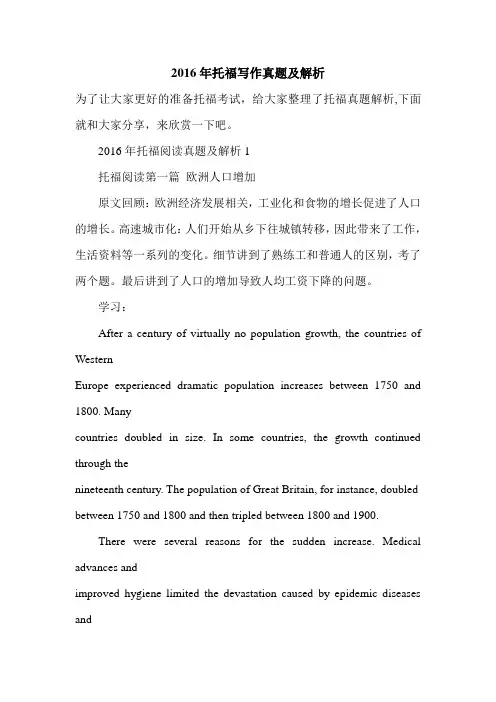
2016年托福写作真题及解析为了让大家更好的准备托福考试,给大家整理了托福真题解析,下面就和大家分享,来欣赏一下吧。
2016年托福阅读真题及解析1托福阅读第一篇欧洲人口增加原文回顾:欧洲经济发展相关,工业化和食物的增长促进了人口的增长。
高速城市化:人们开始从乡下往城镇转移,因此带来了工作,生活资料等一系列的变化。
细节讲到了熟练工和普通人的区别,考了两个题。
最后讲到了人口的增加导致人均工资下降的问题。
学习:After a century of virtually no population growth, the countries of WesternEurope experienced dramatic population increases between 1750 and 1800. Manycountries doubled in size. In some countries, the growth continued through thenineteenth century. The population of Great Britain, for instance, doubled between 1750 and 1800 and then tripled between 1800 and 1900.There were several reasons for the sudden increase. Medical advances andimproved hygiene limited the devastation caused by epidemic diseases andplagues. The introduction of new food crops, most notably the potato, provided abetter diet for the poor and reduced the incidence of famine. The combination ofgreater public order and fewer civil wars meant that life was less hazardous.The net result was a lower death rate and soaring populations.The growing population, with a rising proportion of children to raise andolder people to care for, put increased pressure on every aspect of society. Many peasants were no longer able to provide land for their children, who wereforced to look for other ways to make their living. Small artisans in the citiessuffered similar problems, unable to provide places for their children in theirown workshops.The exact relationship between population growth and industrialization isunclear, though the two are clearly intertwined. (Even countries that were lateto industrialize shared in the general population increase, and its relatedproblems.) What is clear is that the growth in population increased the demandfor both food and manufactured goods and provided an abundance of cheap labor toproduce them.托福阅读第二篇非洲铁技术的发展原文回顾:非洲铁的发展,非洲曾经是被殖民的地方,殖民者大量开采非洲的铁矿资源,并且他们在非洲大规模的用铁矿资源冶炼金属,牵扯到起源,谁把铁的技术引进非洲,以及铁技术之后的发展和改变。
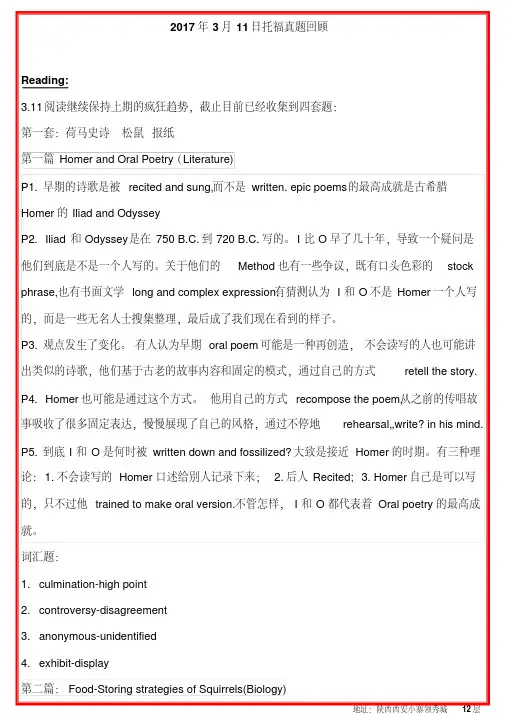
2017年3月11日托福真题回顾Reading:3.11阅读继续保持上期的疯狂趋势,截止目前已经收集到四套题:第一套:荷马史诗松鼠报纸第一篇Homer and Oral Poetry(Literature)P1. 早期的诗歌是被recited and sung, 而不是written. epic poems的最高成就是古希腊Homer的Iliad and OdysseyP2. Iliad和Odyssey是在750 B.C. 到720 B.C. 写的。
I比O早了几十年,导致一个疑问是他们到底是不是一个人写的。
关于他们的Method也有一些争议,既有口头色彩的stock phrase, 也有书面文学long and complex expression.有猜测认为I和O不是Homer一个人写的,而是一些无名人士搜集整理,最后成了我们现在看到的样子。
P3. 观点发生了变化。
有人认为早期oral poem可能是一种再创造,不会读写的人也可能讲出类似的诗歌,他们基于古老的故事内容和固定的模式,通过自己的方式retell the story. P4. Homer也可能是通过这个方式。
他用自己的方式recompose the poem, 从之前的传唱故事吸收了很多固定表达,慢慢展现了自己的风格,通过不停地rehearsal, ,write? in his mind. P5. 到底I和O是何时被written down and fossilized? 大致是接近Homer的时期。
有三种理论:1. 不会读写的Homer口述给别人记录下来; 2. 后人Recited; 3. Homer自己是可以写的,只不过他trained to make oral version. 不管怎样,I和O都代表着Oral poetry的最高成就。
词汇题:1. culmination-high point2. controversy-disagreement3. anonymous-unidentified4. exhibit-display第二篇:Food-Storing strategies of Squirrels(Biology)P1. 精于贮藏食物是Squirrels的特征,简单讲了其中比较典型的territorial pine squirrels store cone的方式。
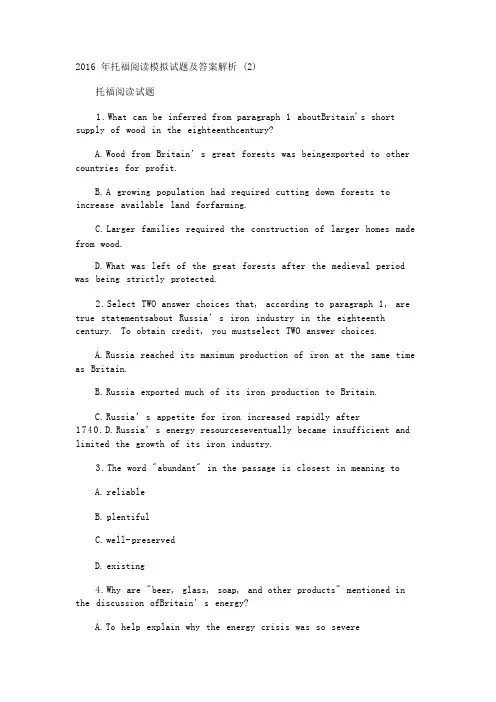
2016 年托福阅读模拟试题及答案解析 (2)托福阅读试题1.What can be inferred from paragraph 1 aboutBritain's short supply of wood in the eighteenthcentury?A.Wood from Britain’s great forests was beingexported to other countries for profit.B.A growing population had required cutting down forests to increase available land forfarming.rger families required the construction of larger homes made from wood.D.What was left of the great forests after the medieval period was being strictly protected.2.Select TWO answer choices that, according to paragraph 1, are true statementsabout Russia’s iron industry in the eighteenth century. To obtain credit, you mustselect TWO answer choices.A.Russia reached its maximum production of iron at the same time as Britain.B.Russia exported much of its iron production to Britain.C.Russia’s appetite for iron increased rapidly after 1740.D.Russia’s energy resourceseventually became insufficient and limited the growth of its iron industry.3.The word "abundant" in the passage is closest in meaning toA.reliableB.plentifulC.well-preservedD.existing4.Why are "beer, glass, soap, and other products" mentioned in the discussion ofBritain’s energy?A.To help explain why the energy crisis was so severeB.To show that despite the energy crisis and as early as 1640, London homes were advancedand well suppliedC.To emphasize that after 1640, British homes required energy for more than heatD.To indicate that coal had been used for the production of certain products before theeighteenth century5.According to paragraph 3, all of the following are ways in which the Savery andNewcomen engines were similar EXCEPT:A.Both became relatively inexpensive after the 1770s.B.Both produced steam by burning coal.C.Both were used to operate pumps.D.Both were very inefficient.6.The word "gifted" in the passage is closest in meaning toA.independentB.talentedC.famousD.ambitious7.According to paragraph 4, what was James Watt’s major achievement?A. He was able to apply his understanding of physics to invent a variety of scientificinstruments and tools for skilled crafts workers.B.He taught university physics courses to outstanding students whose observations led tomany patented inventions.C.He improved the efficiency of Newcomen’s engine by preventing energy from being lost.D.He redesigned Newcomen’s engine so that it no longer needed a separate condenser.8.The word "splendid" in the passage is closest in meaning toA.originalB.necessaryC.magnificentD.popular9.Which of the following is NOT mentioned in paragraph 5 as a development thatgreatly changed the production of iron?A.The use of coke in the smelting of pig ironB.The invention of a furnace that used coke to refine ironC.The discovery of a method for increasing the production of charcoalD.The invention of powerful machinery that could shape, form, and finish iron10.In paragraph 6, why does the author compare British iron production in 1740 withthat of 1844?A.To contrast the amounts of iron needed in Britain in two different centuriesB.To illustrate how easy it was to make money using Cort’s inventionC.To demonstrate the tremendous growth of the iron industry in BritainD.To demonstrate how inexpensive coal had become11.The word "indispensable" in the passage is closest in meaning toA.advantageousB.essentialC.less costlyD.highly stimulating12.According to the passage, which of the following is true about the development ofsteam power?A.The steam engine’s basic technology can be traced back to medieval Britain when steam-powered machinery was being tried in farming activities.B.Although Russia and Britain developed steam-power technology simultaneously,Britain wasfirst to try it in a large-scale industry due to a greater need for iron.C.Steam-power technology was largely the result of improvements developed to increase thesupply of coal as a primary source of energy.D.Adaptations to steam engines required for their use in cotton-spinning mills led to radicaldevelopments in machinery used in the iron industry.13. Look at the four squares [■] that indicate where the following sentence could beadded to the passage.Where would the sentence best fit? Energy had not been aproblem for Britain in the past because it relied on a rich source of energy: its vastforests.By the eighteenth century,Britain was experiencing a severe shortage of energy. ■【A】 Because of the growth of population, most of the great forests of medieval Britain had longago been replaced by fields of grain and hay. ■【B】Wood was in ever-shorter supply, yet itremained tremendously important.■【C】It served as the primary source of heat for allhomes and industries and as a basic raw material.■【D】Processed wood (charcoal) was thefuel that was mixed with iron ore in the blast furnace to produce pig iron (raw iron). The ironindustry’s appetite for wood was enormous, and by 1740 the British iron industry wasstagnating.Vast forests enabled Russia to become the world’s leading producer of iron,much ofwhich was exported to Britain.But Russia’s potential for growth was limited too,and in a fewdecades Russia would reach the barrier of inadequate energy that was already holdingEngland back.14. Directions: An introductory sentence for a brief summary of the passage of thepassage is provided plete the summary by selecting the THREE answerchoices that express the most important ideas in the passage.Some answer choicesdo not belong in the summary because they express ideas that are not presented inthe passage or are minor ideas in the passage. This questions is worth 2 points.By the eighteenth century,Britain was experiencing a severe shortage of energy.A.The development of blast furnaces for the manufacture of pig iron made the Britain lessdependent on wood.B.After the medieval period, both Russia and Britain began to look for alternative sources ofenergy, such as steam power, in order to maintain the growth of their iron industries.C.Two inventors designed the first steam engines in order to overcome the disadvantages ofrelying on horses to power the pumps used in mining coal.D.James Watt was able to improve upon the efficiency of the steam engine and make it usefulto several industries.E.The puddling furnace increased the availability of charcoal to a variety of industries fromcotton to iron production.F.Steam power increased coal production,which in turn allowed extraordinary growth of theiron industry and the British economy.托福阅读答案1.B2.BD3.B4.D5.A6.B7.C8.C9.C10.C11.B12.C13.A14.CDF。

托福阅读专项练习题及答案2016年托福阅读专项练习题及答案Naturalists and casual observers alike have been struck by the special relationship between squirrels and acorns (the seeds of oak trees). Ecologists, though, cannot observe these energetic mammals scurrying up and down oak trees and eating and burying acorns without wondering about their complex relationship with trees. Are squirrels dispersers and planters of oak forests or pesky seed predators? The answer is not simple. Squirrels may devour many acorns, but by storing and failing to recover up to 74 percent of them as they do when seedsare abundant, these arboreal rodents can also aid regeneration and dispersal of the oaks.Their destructive powers are well documented. According to one report, squirrels destroyed tens of thousands of fallen acorns from an oak stand on the University of Indiana campus. A professor there estimated that each of the large white oaks had produced between two and eight thousand acorns, but within weeks of seed maturity, hardly anintact acorn could be found among the fallen leaves.Deer, turkey, wild pigs, and bears also feed heavily on acorns, but do not store them, and are therefore of no benefit to the trees. Flying squirrels, chipmunks, and mice are also unlikely to promote tree dispersal, as they often store seeds in tree cavities and underground burrows. Only squirrels — whose behavior of caching (hiding) acorns below the leaf litter — often promote successful germination of acorns, and perhaps blue jays, important long-distance dispersers, seem to help oaks spread and reproduce.Among squirrels, though, there is a particularly puzzling behavior pattern. Squirrels pry off the caps of acorns, bite through the shells to get at the nutritious inner kernels, and then discard themhalf-eaten. The ground under towering oaks is often littered with thousands of half-eaten acorns, each one only bitten from the top. Why would any animal waste so much time and energy and risk exposure to such predators as red-tail hawks only to leave a large part of each acorn uneaten? While research is not conclusive at this point, one thing thatis certain is that squirrels do hide some of the uneaten portions, and these acorn halves, many of which contain the seeds, may later germinate.1. What does the passage mainly discuss?(A) The ecology of oak trees(B) Factors that determine the feeding habits of Squirrels(C) Various species of animals that promote the dispersal of tree seeds(D) The relationship between squirrels and oak trees2. The word "they" in line 7 refers to(A) oak forests(B) acorns(C) squirrels(D) predators3. According to the passage , what do squirrels do when large quantities of acorns are available?(A) They do not store acorns.(B) They eat more than 74 percent of available acorns.(C) They do not retrieve all the acorns that they have stored.(D) They hide acorns in tree cavities.4. The word "estimated评价,估计,估价,判断" in line 11 is closest in meaning to(A) commented(B) judged(C) observed(D) discovered5. Why does the author mention "the University of Indiana campus" in line 10 -11?(A) to provide evidence that intact acorns are hard to find under oak trees(B) to indicate a place where squirrels can aid seed dispersal of oaks(C) to argue in favor of additional studies concerning the destructive force of squirrels(D) to support the claim that squirrels can do great damage to oak stands6. It can be inferred from paragraph 3 that chipmunks do not aid in the dispersal of oak trees because(A) they store their acorns where they cannot germinate(B) they consume most of their stored acorns(C) their stored acorns are located and consumed by other species(D) they cannot travel the long distance required for dispersal7. According to the passage , which of the following dosquirrels and blue jays have in common?(A) They travel long distances to obtain acorns.(B) They promote the reproduction of oak trees.(C) They bury acorns under fallen leaves.(D) They store large quantities of acorns.8. The phrase "pry 撬off" in line 21 is closest in meaning to(A) swallow 吞(B) remove(C) squeeze(D) locate9. The word "littered" in line 22 is closest in meaning to(A) covered(B) displayed(C) fertilized(D) planted10. According to the passage , scientists cannot explain which of the following aspects of squirrel behavior?(A) Where squirrels store their acorn caches(B) Why squirrels prefer acorns over other seeds(C) Why squirrels eat only a portion of each acorn they retrieve(D) Why squirrels prefer acorns from a particular species of oak treesDCCBD DBBAC。
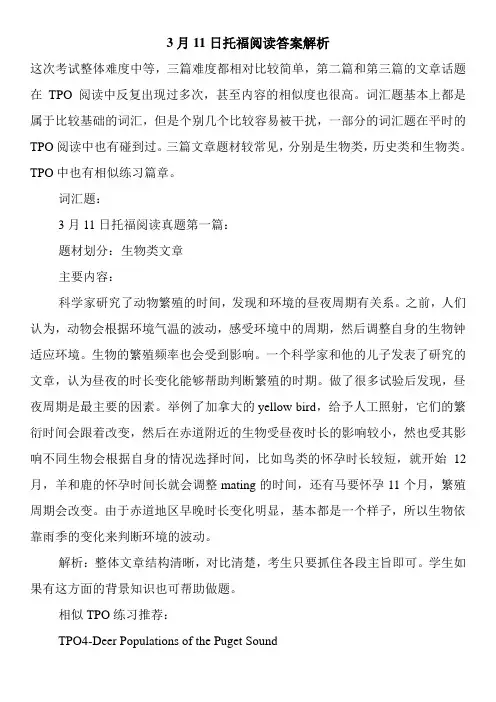
3月11日托福阅读答案解析这次考试整体难度中等,三篇难度都相对比较简单,第二篇和第三篇的文章话题在TPO阅读中反复出现过多次,甚至内容的相似度也很高。
词汇题基本上都是属于比较基础的词汇,但是个别几个比较容易被干扰,一部分的词汇题在平时的TPO阅读中也有碰到过。
三篇文章题材较常见,分别是生物类,历史类和生物类。
TPO中也有相似练习篇章。
词汇题:3月11日托福阅读真题第一篇:题材划分:生物类文章主要内容:科学家研究了动物繁殖的时间,发现和环境的昼夜周期有关系。
之前,人们认为,动物会根据环境气温的波动,感受环境中的周期,然后调整自身的生物钟适应环境。
生物的繁殖频率也会受到影响。
一个科学家和他的儿子发表了研究的文章,认为昼夜的时长变化能够帮助判断繁殖的时期。
做了很多试验后发现,昼夜周期是最主要的因素。
举例了加拿大的yellow bird,给予人工照射,它们的繁衍时间会跟着改变,然后在赤道附近的生物受昼夜时长的影响较小,然也受其影响不同生物会根据自身的情况选择时间,比如鸟类的怀孕时长较短,就开始12月,羊和鹿的怀孕时间长就会调整mating的时间,还有马要怀孕11个月,繁殖周期会改变。
由于赤道地区早晚时长变化明显,基本都是一个样子,所以生物依靠雨季的变化来判断环境的波动。
解析:整体文章结构清晰,对比清楚,考生只要抓住各段主旨即可。
学生如果有这方面的背景知识也可帮助做题。
相似TPO练习推荐:TPO4-Deer Populations of the Puget SoundTPO15-A Warm-Blooded Turtle3月11日托福阅读真题第二篇题材划分:历史类文章主要内容:工业发展的原因:人口增长、工具以及机械的进步和发展,由于家庭关系的改变导致特殊分工的出现。
人口增长,就业压力变大,农田并没有那么多,所以不得不接受新的工作岗位。
工业发展使工人们开始有各种分工,都是负责每一个人的step,机械会取代劳动力,所以工人开始负责不同的任务分工。
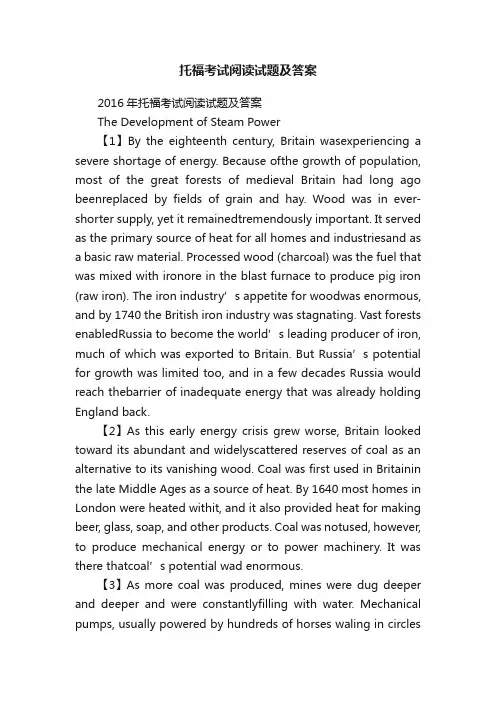
托福考试阅读试题及答案2016年托福考试阅读试题及答案The Development of Steam Power【1】By the eighteenth century, Britain wasexperiencing a severe shortage of energy. Because ofthe growth of population, most of the great forests of medieval Britain had long ago beenreplaced by fields of grain and hay. Wood was in ever-shorter supply, yet it remainedtremendously important. It served as the primary source of heat for all homes and industriesand as a basic raw material. Processed wood (charcoal) was the fuel that was mixed with ironore in the blast furnace to produce pig iron (raw iron). The iron industry’s appetite for woodwas enormous, and by 1740 the British iron industry was stagnating. Vast forests enabledRus sia to become the world’s leading producer of iron, much of which was exported to Britain. But Russia’s potential for growth was limited too, and in a few decades Russia would reach thebarrier of inadequate energy that was already holding England back.【2】As this early energy crisis grew worse, Britain looked toward its abundant and widelyscattered reserves of coal as an alternative to its vanishing wood. Coal was first used in Britainin the late Middle Ages as a source of heat. By 1640 most homes in London were heated withit, and it also provided heat for making beer, glass, soap, and other products. Coal was notused, however, to produce mechanical energy or to power machinery. It was there thatcoal’s potential wad enormous.【3】As more coal was produced, mines were dug deeper and deeper and were constantlyfilling with water. Mechanical pumps, usually powered by hundreds of horses waling in circlesatthe surface, had to be installed Such power was expensive and bothersome. In an attempt toovercome these disadvantages, Thomas Savery in 1698 and Thomas Newcomen in 1705 invented the first primitive steam engines. Both engines were extremely inefficient. Bothburned coal to produce steam, which was then used to operate a pump. However, by theearly 1770s, many of the Savery engines and hundreds of the Newcomen engines wereoperating successfully, though inefficiently, in English and Scottish mines.【4】In the early 1760s, a gifted young Scot named James Watt was drawn to a critical studyof the steam engine. Watt was employed at the time by the University of Glasgow as a skilledcrafts worker making scientific instruments. In 1763: Watt was called on to repair a Newcomenengine being used in a physics course. After a series of observations, Watt saw that theNewcomen’s wast e of energy could be reduced by adding a separate condenser. This splendidinvention, patented in 1769, greatly increased the efficiency of the steam engine. The steamengine of Watt and his followers was the technological advance that gave people, at least for awhile, unlimited power and allowed the invention and use of all kinds of power equipment.【5】The steam engine was quickly put to use in several industries in Britain. It drained minesand made possible the production of ever more coal to feed steam engines elsewhere. Thesteam power plant began to replace waterpower in the cotton-spinning mills as well as otherindustries during the 1780s, contributing to a phenomenal rise in industrialization. TheBritish iron industry was radically transformed. The use of powerful, steam-driven bellows inblast furnaces helped iron makers switchover rapidly from limited charcoal to unlimited coke(which is made from coal) in the smelting of pig iron (the process of refining impure iron) after1770 in the 1780s, Henry Cort developed the puddling furnace, which allowed pig iron to berefined in turn with coke. Cort also developed heavy-duty, steam-powered rolling mills, whichwere capable of producing finished iron in every shape and form.【6】The economic consequence of these technical innovations in steam power was a greatboom in the British iron industry. In 1740 annual British iron production was only 17:000 tons, but by 1844: with the spread of coke smelting and the impact of Cort’s inventions, it hadincreased to 3,000:000 to ns. This was a truly amazing expansion. Once scarce and expensive, iron became cheap, basic, and indispensable to the economy.试题1.What can be inferred from paragraph 1 aboutBritain's short supply of wood in the eighteenthcentury?A.Wood from Britain’s gr eat forests was beingexported to other countries for profit.B.A growing population had required cutting down forests to increase available land forfarming.rger families required the construction of larger homes made from wood.D.What was left of the great forests after the medieval period was being strictly protected.2.Select TWO answer choices that, according to paragraph 1, are true statementsabout Russia’s iron industry in the eighteenth century. To obtain credit, you mustselect TWO answer choices.A.Russia reached its maximum production of iron at the sametime as Britain.B.Russia exported much of its iron production to Britain.C.Russia’s appetite for iron increased rapidly after 1740.D.Russia’s energy resourceseventually became insufficient and limited the growth of its iron industry.3.The word "abundant" in the passage is closest in meaning toA.reliableB.plentifulC.well-preservedD.existing4.Why are "beer, glass, soap, and other products" mentioned in the discussion ofBritain’s energy?A.To help explain why the energy crisis was so severeB.To show that despite the energy crisis and as early as 1640, London homes were advancedand well suppliedC.To emphasize that after 1640, British homes required energy for more than heatD.To indicate that coal had been used for the production of certain products before theeighteenth century5.According to paragraph 3, all of the following are ways in which the Savery andNewcomen engines were similar EXCEPT:A.Both became relatively inexpensive after the 1770s.B.Both produced steam by burning coal.C.Both were used to operate pumps.D.Both were very inefficient.6.The word "gifted" in the passage is closest in meaning toA.independentB.talentedC.famousD.ambitious7.According to paragraph 4, what was Jam es Watt’s major achievement?A. He was able to apply his understanding of physics to invent a variety of scientificinstruments and tools for skilled crafts workers.B.He taught university physics courses to outstanding students whose observations led tomany patented inventions.C.He improved the efficiency of Newcomen’s engine by preventing energy from being lost.D.He redesigned Newcomen’s engine so that it no longer needed a separate condenser.8.The word "splendid" in the passage is closest in meaning toA.originalB.necessaryC.magnificentD.popular9.Which of the following is NOT mentioned in paragraph 5 as a development thatgreatly changed the production of iron?A.The use of coke in the smelting of pig ironB.The invention of a furnace that used coke to refine ironC.The discovery of a method for increasing the production of charcoalD.The invention of powerful machinery that could shape, form, and finish iron10.In paragraph 6, why does the author compare British iron production in 1740 withthat of 1844?A.To contrast the amounts of iron needed in Britain in two different centuriesB.To illustrate how easy it was to make money using Cort’s inventionC.To demonstrate the tremendous growth of the iron industry in BritainD.To demonstrate how inexpensive coal had become11.The word "indispensable" in the passage is closest in meaning toA.advantageousB.essentialC.less costlyD.highly stimulating12.According to the passage, which of the following is true about the development ofsteam power?A.The steam e ngine’s basic technology can be traced back to medieval Britain when steam-powered machinery was being tried in farming activities.B.Although Russia and Britain developed steam-power technology simultaneously, Britain wasfirst to try it in a large-scale industry due to a greater need for iron.C.Steam-power technology was largely the result of improvements developed to increase thesupply of coal as a primary source of energy.D.Adaptations to steam engines required for their use in cotton-spinning mills led to radicaldevelopments in machinery used in the iron industry.13. Look at the four squares [■] that indicate where the following sentence could beadded to the passage. Where would the sentence best fit? Energy had not been aproblem for Britain in the past because it relied on a rich source of energy: its vastforests.By the eighteenth century, Britain was experiencing a severe shortage of energy. ■【A】 Because of the growth of population, most of the great forests of medieval Britain had longago been repl aced by fields of grain and hay. ■【B】Wood was in ever-shorter supply, yet itremained tremendously important. ■【C】It served as the primary source of heat for allhomes and industries and as a basic raw material. ■【D】Processed wood (charcoal) was thefuel that was mixed with iron ore in the blast furnace to produce pig iron (raw iron). The ironindustry’s appetite for wood was enormous, and by 1740 the British iron industry wasstagnating. Vast forests enabled Russia to become the world’s leading producer of iron, much ofwhich was exported to Britain. But Russia’s potential for growth was limited too, and in a fewdecades Russia would reach the barrier of inadequate energy that was already holdingEngland back.14. Directions: An introductory sentence for a brief summary of the passage of thepassage is provided below. Complete the summary by selecting the THREE answerchoices that express the most important ideas in the passage. Some answer choicesdo not belong in the summary because they express ideas that are not presented inthe passage or are minor ideas in the passage. This questions is worth 2 points.By the eighteenth century, Britain was experiencing a severe shortage of energy.A.The development of blast furnaces for the manufacture of pig iron made the Britain lessdependent on wood.B.After the medieval period, both Russia and Britain began to look for alternative sources ofenergy, such as steam power, in order to maintain the growth of their iron industries.C.Two inventors designed the first steam engines in order toovercome the disadvantages ofrelying on horses to power the pumps used in mining coal.D.James Watt was able to improve upon the efficiency of the steam engine and make it usefulto several industries.E.The puddling furnace increased the availability of charcoal to a variety of industries fromcotton to iron production.F.Steam power increased coal production, which in turn allowed extraordinary growth of theiron industry and the British economy.参考答案1.B2.BD3.B4.D5.A6.B7.C8.C9.C 10.C 11.B 12.C 13.A 14.CDF。
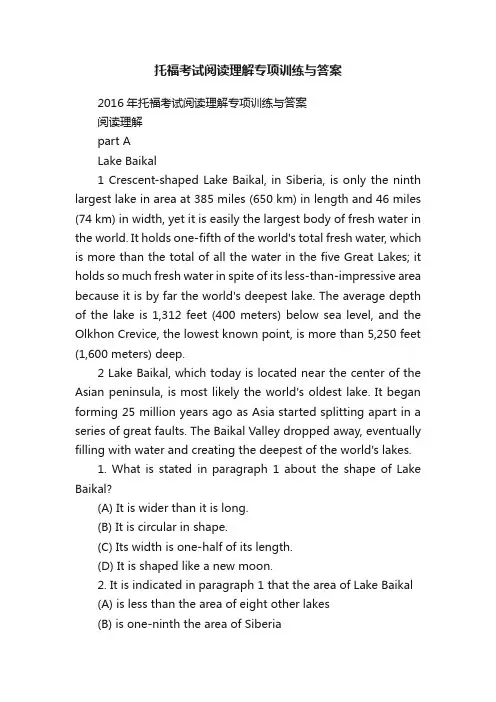
托福考试阅读理解专项训练与答案2016年托福考试阅读理解专项训练与答案阅读理解part ALake Baikal1 Crescent-shaped Lake Baikal, in Siberia, is only the ninth largest lake in area at 385 miles (650 km) in length and 46 miles (74 km) in width, yet it is easily the largest body of fresh water in the world. It holds one-fifth of the world's total fresh water, which is more than the total of all the water in the five Great Lakes; it holds so much fresh water in spite of its less-than-impressive area because it is by far the world's deepest lake. The average depth of the lake is 1,312 feet (400 meters) below sea level, and the Olkhon Crevice, the lowest known point, is more than 5,250 feet (1,600 meters) deep.2 Lake Baikal, which today is located near the center of the Asian peninsula, is most likely the world's oldest lake. It began forming 25 million years ago as Asia started splitting apart in a series of great faults. The Baikal Valley dropped away, eventually filling with water and creating the deepest of the world's lakes.1. What is stated in paragraph 1 about the shape of Lake Baikal?(A) It is wider than it is long.(B) It is circular in shape.(C) Its width is one-half of its length.(D) It is shaped like a new moon.2. It is indicated in paragraph 1 that the area of Lake Baikal(A) is less than the area of eight other lakes(B) is one-ninth the area of Siberia(C) is greater than the area of any other freshwater lake(D) is equal to the area of the five Great Lakes3. According to paragraph 1, Lake Baikal(A) holds one-fifth of the world's water(B) holds five times the water of the Great Lakes(C) holds one-ninth of the world's water(D) holds 20 percent of the world's fresh water4. According to paragraph 1, the Olkhon Crevice is(A) outside of Lake Baikal(B) 400 meters below sea level(C) the deepest part of Lake Baikal(D) 5,000 meters deep5. It is mentioned in paragraph 2 that Lake Baikal(A) is not as old as some other lakes(B) formed when sections of the Earth were moving away from each other(C) was fully formed 25 million years ago(D) is today located on the edge of the Asian peninsula参考答案:1-5:D、A、D、C、Bpart BThe Postage Stamp1 The postage stamp has been around for only a relatively short period of time. The use of stamps for postage was first proposed in England in 1837, when Sir Rowland Hill published a pamphlet entitled "Post Office Reform: Its Importance and Practicability" to put forth the ideas that postal rates should not be based on the distance that a letter or package travels but should instead be based on the weight of the letter or package and that fees for postal services should be collected in advanceof the delivery, rather than after, through the use of postage stamps.2 The ideas proposed by Hill went into effect in England almost immediately, and other countries soon followed suit. The first English stamp, which featured a portrait of then Queen Victoria, was printed in 1840. This stamp, the "penny black," came in sheets that needed to be separated with scissors and provided enough postage for a letter weighing 14 grams or less to any destination. In 1843, Brazil was the next nation to produce national postage stamps, and various areas in what is today Switzerland also produced postage stamps later in the same year. Postage stamps in five-and ten-cent denominations were first approved by the U.S. Congress in 1847, and by 1860 postage stamps were being issued in more than 90 governmental jurisdictions worldwide.6. According to paragraph 1, postage stamps were first suggested(A) in the first half of the eighteenth century(B) in the second half of the eighteenth century(C) in the first half of the nineteenth century(D) in the second half of the nineteenth century7. It is indicated in paragraph 1 that Sir Rowland Hill believed that postage fees(A) should be paid by the sender(B) should be related to distance(C) should have nothing to do with how heavy a package is(D) should be collected after the package is delivered8. What is stated in paragraph 2 about the first English postage stamp?(A) It was designed by Queen Victoria.(B) It contained a drawing of a black penny.(C) It was produced in sheets of 14 stamps.(D) It could be used to send a lightweight letter.9. According to paragraph 2, Brazil introduced postage stamps(A) before England(B) before Switzerland(C) after the United States(D) after Switzerland10. It is mentioned in paragraph 2 that in 1847(A) postage stamps were in use in 90 different countries(B) it cost fifteen cents to mail a letter in the United States(C) two different denominations of postage stamps were introduced in the United States(D) the U.S. Congress introduced the "penny black" stamp参考答案:6-10:A、A、D、B、Cpart CThe Clovis Culture1 Archeologists have found sites all over North America that contain similar tools dating from a period about 12,000 years ago. The culture that developed these tools has been named Clovis after the site near Clovis, New Mexico, where the first tools of this sort were discovered in 1932. The tools are quite sophisticated and are unlike any tools that have been found in the Old World.2 In the years since the first tools of this sort were discovered in New Mexico, archeologists have discovered Clovis tools in areas ranging from Mexico to Montana in the United States and Nova Scotia in Canada. All of the Clovis finds date from approximately the same period, a fact which suggests that the Clovis spread rapidly throughout the North American continent.3 From the evidence that has been discovered, archeologists have concluded that the Clovis were a mobile culture. They traveled in groups of 40 to 50 individuals, migrating seasonally and returning to the same hunting camps each year. Their population increased rapidly as they spread out over the continent, and they were quite possibly motivated to develop their sophisticated hunting tools to feed their rapidly expanding populace.11. What is stated in paragraph 1 about Clovis tools?(A) They date from around 10,000 B.C.(B) They have been in use for 12,000 years.(C) They have been found at only one location.(D) They were discovered by archeologists hundreds of years ago.12. According to paragraph 1, the town of Clovis(A) is in Mexico(B) was founded in 1932(C) is where all members of the Clovis culture lived(D) is where the first remnants of an ancient culture were found13. It is indicated in paragraph 1 that the tools found near Clovis, New Mexico, were(A) very rudimentary(B) similar to others found prior to 1932(C) rather advanced(D) similar to some found in Africa and Europe14. According to paragraph 2, what conclusion have archeologists drawn from the Clovis finds?(A) That the Clovis tended to remain in one place(B) That the Clovis expanded relatively quickly(C) That the Clovis lived throughout the world(D) That the Clovis were a seafaring culture15. It is mentioned in paragraph 3 that it is believed that the Clovis(A) lived in familial groups of four or five people(B) had a relatively stable population(C) lived only in New Mexico(D) spent summers and winters in different places参考答案:11-15:A、D、C、B、D。
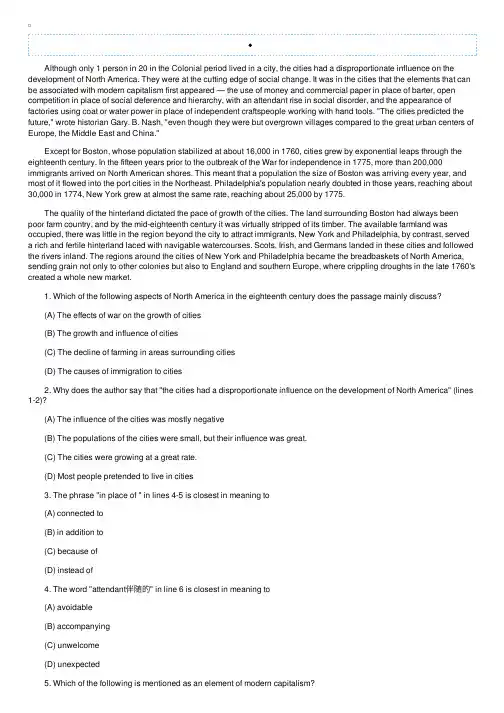
Although only 1 person in 20 in the Colonial period lived in a city, the cities had a disproportionate influence on the development of North America. They were at the cutting edge of social change. It was in the cities that the elements that can be associated with modern capitalism first appeared — the use of money and commercial paper in place of barter, open competition in place of social deference and hierarchy, with an attendant rise in social disorder, and the appearance of factories using coat or water power in place of independent craftspeople working with hand tools. "The cities predicted the future," wrote historian Gary. B. Nash, "even though they were but overgrown villages compared to the great urban centers of Europe, the Middle East and China." Except for Boston, whose population stabilized at about 16,000 in 1760, cities grew by exponential leaps through the eighteenth century. In the fifteen years prior to the outbreak of the War for independence in 1775, more than 200,000 immigrants arrived on North American shores. This meant that a population the size of Boston was arriving every year, and most of it flowed into the port cities in the Northeast. Philadelphia's population nearly doubted in those years, reaching about 30,000 in 1774, New York grew at almost the same rate, reaching about 25,000 by 1775. The quality of the hinterland dictated the pace of growth of the cities. The land surrounding Boston had always been poor farm country, and by the mid-eighteenth century it was virtually stripped of its timber. The available farmland was occupied, there was little in the region beyond the city to attract immigrants. New York and Philadelphia, by contrast, served a rich and fertile hinterland laced with navigable watercourses. Scots, Irish, and Germans landed in these cities and followed the rivers inland. The regions around the cities of New York and Philadelphia became the breadbaskets of North America, sending grain not only to other colonies but also to England and southern Europe, where crippling droughts in the late 1760's created a whole new market. 1. Which of the following aspects of North America in the eighteenth century does the passage mainly discuss? (A) The effects of war on the growth of cities (B) The growth and influence of cities (C) The decline of farming in areas surrounding cities (D) The causes of immigration to cities 2. Why does the author say that "the cities had a disproportionate influence on the development of North America" (lines 1-2)? (A) The influence of the cities was mostly negative (B) The populations of the cities were small, but their influence was great. (C) The cities were growing at a great rate. (D) Most people pretended to live in cities 3. The phrase "in place of " in lines 4-5 is closest in meaning to (A) connected to (B) in addition to (C) because of (D) instead of 4. The word "attendant伴随的" in line 6 is closest in meaning to (A) avoidable (B) accompanying (C) unwelcome (D) unexpected 5. Which of the following is mentioned as an element of modern capitalism? (B) Social deference (C) Social hierarchy (D) Independent craftspeople 6. It can be inferred that in comparison with North American cities, cities in Europe, the Middle East, and China had (A) large populations (B) little independence (C) frequent social disorder (D) few power sources 7. The phrase "exponential迅猛的 leaps" in line 12 is closest in meaning to (A) long wars (B) new laws (C) rapid increases (D) exciting changes 8. The word "it" in line 15 refers to (A) population (B) size (C) Boston (D) Year 9. How many immigrants arrived in North America between 1760 and 1775? (A) About 16,000 (B) About 25,000 (C) About 30,000 (D) More than 200,000 10. The word "dictated决定" in line 18 is closest in meaning to (A) spoiled (B) reduced (C) determined (D) divided 11. The word "virtually⼏乎" in line 20 is closest in meaning to (A) usually (B) hardly (C) very quickly (D) almost completely 12. The region surrounding New York and Philadelphia is contrasted with the region surrounding Boston in terms of (B) origin of immigrants (C) opportunities for fishing (D) type of grain grown 13. Why does the author describe the regions around the cities of New York and Philadelphia as "breadbaskets"? (A) They produced grain especially for making bread. (B) They stored large quantities of grain during periods of drought (C) They supplied grain to other parts of North America and other countries. (D) They consumed more grain than all the other regions of North America. BBDBA ACADC DAC。
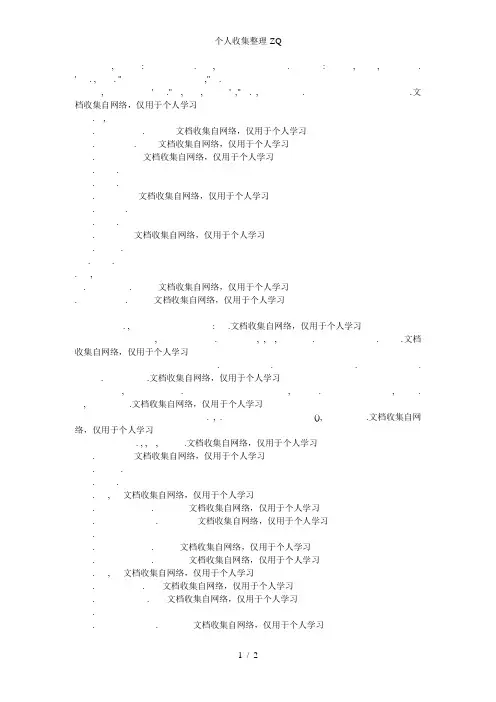
, : . , . : , , . ' . , . " ," ., ' ." , , ' ," . , . .文档收集自网络,仅用于个人学习. ,. . 文档收集自网络,仅用于个人学习. . 文档收集自网络,仅用于个人学习. 文档收集自网络,仅用于个人学习. .. .. 文档收集自网络,仅用于个人学习. .. .. 文档收集自网络,仅用于个人学习. .. .. ,. . 文档收集自网络,仅用于个人学习. . 文档收集自网络,仅用于个人学习. , : .文档收集自网络,仅用于个人学习, . , , , . . .文档收集自网络,仅用于个人学习. . . .. .文档收集自网络,仅用于个人学习, . , . , . , .文档收集自网络,仅用于个人学习. , . (), .文档收集自网络,仅用于个人学习. , , , .文档收集自网络,仅用于个人学习. 文档收集自网络,仅用于个人学习. .. .. , 文档收集自网络,仅用于个人学习. . 文档收集自网络,仅用于个人学习. . 文档收集自网络,仅用于个人学习.. . 文档收集自网络,仅用于个人学习. . 文档收集自网络,仅用于个人学习. , 文档收集自网络,仅用于个人学习. . 文档收集自网络,仅用于个人学习. . 文档收集自网络,仅用于个人学习.. . 文档收集自网络,仅用于个人学习. . 文档收集自网络,仅用于个人学习年月全国英语等级考试三级真题(阅读)真题答案:.........。
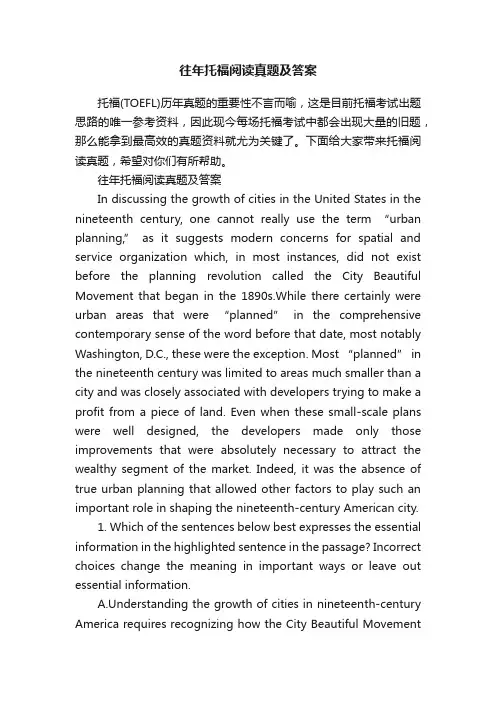
往年托福阅读真题及答案托福(TOEFL)历年真题的重要性不言而喻,这是目前托福考试出题思路的唯一参考资料,因此现今每场托福考试中都会出现大量的旧题,那么能拿到最高效的真题资料就尤为关键了。
下面给大家带来托福阅读真题,希望对你们有所帮助。
往年托福阅读真题及答案In discussing the growth of cities in the United States in the nineteenth century, one cannot really use the term “urban planning,” as it suggests modern concerns for spatial and service organization which, in most instances, did not exist before the planning revolution called the City Beautiful Movement that began in the 1890s.While there certainly were urban areas that were “planned” in the comprehensive contemporary sense of the word before that date, most notably Washington, D.C., these were the excepti on. Most “planned” in the nineteenth century was limited to areas much smaller than a city and was closely associated with developers trying to make a profit from a piece of land. Even when these small-scale plans were well designed, the developers made only those improvements that were absolutely necessary to attract the wealthy segment of the market. Indeed, it was the absence of true urban planning that allowed other factors to play such an important role in shaping the nineteenth-century American city.1. Which of the sentences below best expresses the essential information in the highlighted sentence in the passage? Incorrect choices change the meaning in important ways or leave out essential information.A.Understanding the growth of cities in nineteenth-century America requires recognizing how the City Beautiful Movementof the 1890s changed “urban planning.”B.For the most part, there was no “urban planning,” as that term is understood today, before the beginning of the City Beautiful Movement in the 1890s.C.oncerns for spatial and service organization had little impact on the growth of cities before the 1890s when the City Beautiful Movement began.D.The growth of cities in nineteenth-century America resulted in the creation of the City Beautiful Movement in the 1890s and the rise of the term “urban planning.”首先我们先明确题目的要求,其实题目中一共应该是3个核心重点要求:(1)best expresses the essential information in the highlighted sentence in the passage(2)Incorrect choices change the meaning in important ways(3)or leave out essential information.通过对题目的分析我们不难发现,essential这个单词出现了2次,换言之,题目要求大家做的是“找出句子的核心含义”,那么什么算是“核心含义”呢?要明白这个问题就要深刻理解一个概念:英语句内逻辑结构比如although A, B 中 AB两部分为让步转折关系,核心点是转折后的B句,because A, B中AB两部分为因果关系,核心点是结论B句。
2016年全国3卷英语试题(带解析)一、阅读理解MusicOpera at Music Hall: 1243 Elm Street The season runs June through August, with additional performances in March and September. The Opera honors Enjoy the Arts membership discounts. Phone: 241 -2742.Chamber Orchestra: The Orchestra plays al Memorial Hall at 106 Elm Street, which offers several conceits from March through June. Gall 723-1182 for more information..Symphony Orchestra: At Music Hall and Riverbend. For ticket sales, call 381-3300. Regular season runs September through May at Music Hall in summer al Riverbend./honie.asp.College Consen-atory Of Music (CCM): Performances are on the main campus of the university, usually at Patricia Cobbett Theater. CCM organizes a variety of events, including performances by the well-known LaSalle Quarter, CMM's Philharmonic Orchesira, and various groups of musicians presenting Baroque through modem misic. Students withI. D. cards can attend the events for free. A free schedule of events for each term is available by coiling (he box office at 556-4183.m. /events/calendar.Rivebent Music Theater.6295 Kellogg Ave« Large outdoor theater with the closest seats under cover (price difference ). Big name shows all summer long! Phone:232-6220.1.Which number should you call if you want to nee an opera ?A. 241-2742.B. 723-1182.C. 381-330().D. 232-6220.2.When can you go to » concert by Chamber Orchestra?A. February.B. May.C. AugustD. November.3.Where can students go for free performances with their I.D. cards?B. Memorial Hall.A. Music Hall.参考答案1.2.3.4.【分析】文章是一篇广告类短文。
3月19日托福阅读真题及答案解析2016年3月19日托福阅读真题及答案解析在托福备考的四个项目中,相对而言,阅读还是比较难的,就2016年3月19日托福阅读,下面YJBYS店铺为大家搜索整理了相关的真题及答案解析,欢迎参考阅读,希望对大家有所帮助!想了解更多相关信息请持续关注我们应届毕业生培训网!阅读部分词汇题ardent=enthusiasticcompelling=persuasivescanty=fewdistinctive=characteristicsconfine=restrict toresemble= look likelone=singlePassage 1 The extinction trends 灭绝趋势文章解析第一篇文章一共五段,第一段开篇以物种数量的变化趋势引出extinction(大灭绝)的概念,然后对geological time(地质时间)中的extinction的情况做了大体描述。
第二段讨论这些灭绝的原因,除了气候因素、小行星撞地球外,提出人为因素,本段的考题主要是人为因素影响灭绝的时间要注意。
第三段写最近一次的冰川时期,美国北部和亚欧大陆北部都覆盖着广阔的冰川,生活在这些冰川地带南部边界的人们的生活方式为打猎,人们为了获得食物打猎致使大量的物种灭绝。
第四段写农业的产生改变的人们的生活方式,人们为了开垦土地种庄稼进一步破坏自然,导致大量物种的灭绝。
最后一段写欧洲殖民(European colonies)对当地带来的影响,导致物种大量灭绝。
解析:最近连考大灭绝话题,足见ETS对这个话题的重视度。
本篇文章表面上看在讲大灭绝,实质上同样把人类的发展史与物种的灭绝结合起来考,建议考生把文章中涉及的相关背景知识都做一个较好的了解,如:冰川世纪、农业的起源、欧洲和美国发展史,当然学科词汇必不可少。
相信对背景全面的了解、对词汇的熟练的掌握,能够帮考生们很好的应对这篇文章。
参考阅读:TPO 15 Mass ExtinctionsTPO 8 Extinction of the DinosaursTPO 15 Glacier FormationTPO 21 The Origins of AgricultureTPO 33 Extinction Episodes of the PastPassage 2 水生昆虫如何躲避捕食者本篇文章分为四个段落,第一段通过写生物有各种各样的方法伪装自己以便躲避捕食者,引出水生昆虫如何躲避捕食者,主要写颜色这个方面。
托福阅读原⽂ Protection of Plants by Insects 【1】Many plants - one or more species of at least68 different families - can secrete nectar even whenthey have no blossoms, because they bear extrafloral nectaries (structures that producenectar) on stems, leaves, leaf stems, or other structures.These plants usually occur where antsare abundant, most in the tropics but some in temperate areas. Among those of northeasternNorth America are various plums, cherries, roses, hawthorns, poplars, and oaks. Like floralnectar, extrafloral nectar consists mainly of water with a high content of dissolved sugars and, in some plants, small amounts of amino acids. The extrafloral nectaries of some plants areknown to attract ants and other insects, but the evolutionary history of most plants with thesenectaries is unknown. Nevertheless, most ecologists believe that all extrafloral nectaries attractinsects that will defend the plant. 【2】Ants are portably the most frequent and certainly the most persistent defenders ofplants. Since the highly active worker ants require a great deal of energy, plants exploit thisneed by providing extrafloral nectar that supplies ants with abundant energy. To return thisfavor, ants guard the nectaries, driving away or killing intruding insects that might competewith ants for nectar. Many of these intruders are herbivorous and would eat the leaves of theplants. 【3】Biologists once thought that secretion of extrafloral nectar has some purely internalphysiological function, and that ants provide no benefit whatsoever to the plants that secreteit. This view and the opposing “protectionist” hypothesis that ants defend plants had beendisputed for over a hundred years when, in 1910, a skeptical William Morton Wheelercommented on the controversy. He called for proof of the protectionist view: that visitations ofthe ants confer protection on the plants and that in the absence of the insects a much greaternumber would perish or fail to produce flowers or seeds than when the insects are present. That we now have an abundance of the proof that was called for was established whenBarbara Bentley reviewed the relevant evidence in 1977, and since then many moreobservations and experiments have provided still further proof that ants benefit plants. 【4】One example shows how ants attracted to extrafloral nectaries protect morning gloriesagainst attacking insects. The principal insect enemies of the North American morning gloryfeed mainly on its flowers or fruits rather than its leaves. Grasshoppers feeding on flowersindirectly block pollination and the production of seeds by destroying the corolla or thestigma, which receives the pollen grains and on which the pollen germinates. Without theircolorful corolla, flowers do not attract pollinators and are not fertilized. An adult grasshoppercan consume a large corolla, about 2.5 inches long, in an hour. Caterpillars and seed beetlesaffect seed production directly. Caterpillars devour the ovaries, where the seeds are produced, and seed beetle larvae eat seeds as they burrow in developing fruits. 【5】Extrafloral nectaries at the base of each sepal attract several kinds of insects, but 96 percent of them are ants, several different species of them. When buds are still small, lessthan a quarter of an inch long, the sepal nectaries are already present and producing nectar. They continue to do so as the flower develops and while the fruit matures. Observations leavelittle doubt that ants protect morning glory flowers and fruits from the combined enemy forceof grasshoppers, caterpillars, and seed beetles. Bentley compares the seed production of sixplants that grew where there were no ants with that of seventeen plants that were occupied byants. Unprotected plants bore only 45 seeds per plant, but plants occupied by ants bore 211 seeds per plant. Although ants are not big enough to kill or seriously injure grasshoppers, theydrive them away by nipping at their feet. Seed beetles are more vulnerable because they aremuch smaller than grasshoppers. The ants prey on the adult beetles, disturb females astheylay their eggs on developing fruits, and eat many of the eggs they do manage to lay. 托福阅读试题 1.According to paragraph 1,floral nectar andextrafloral nectar are alike in that A.they are likely to be produced by the same plants. B.they basically consist of the same chemicalcomponents. C.they attract only insects that will defend the plant. D.they are produced by the same parts of the plant. 2.To say that ants are "persistent" defenders of plants means that A.they defend plants against a wide variety of threats. B.they continue to defend plants for as long as the plants are threatened. C.they are successful defenders of plants. D.they are easily observable defenders of plants. 3.What can be inferred from paragraph 2 about the ants that are attracted to theextrafloral nectaries? A.They do not eat the leaves of the plants that produce extrafloral nectar. B.They live almost entirely on extrafloral nectar. C.They spend most of their energy guarding extrafloral nectaries. D.They frequently fight among themselves over extrafloral nectar. 4.According to paragraph 3, what was the position of the opponents of the"protectionist" hypothesis? A.Extrafloral nectar provides plants with a direct defense against attack by insects. B.Ants substantially benefit plants that secrete extrafloral nectar. C.The secretion of extrafloral nectar plays a role in the plant’s internal functioning. D.Ants visit plants that secrete extrafloral nectar as often as they visit plants that do not. 5.The word "skeptical" in the passage is closest in meaning to A.curious. B.doubtful. C.open-minded. D.practical. 6.Which of the sentences below best expresses the essential information jn thehighlighted sentence in the passage Incorrect choices change the meaning inimportant ways or leave out essential information. A.We now have ample proof that ants benefit plants. B.Barbara Bentley has called for additional proof that ants benefit plants. C.In 1977 Barbara Bentley conducted research that proved that all prior studies were wrong. D.Proof that ants benefit plants will require many more observations and experiments. 7.According to paragraph 4, what effect does the destruction of the corolla have onplants. A.It leaves the seeds exposed and unprotected. B.It prevents the stigma from developing. C.It keeps pollen grains from attaching properly. D.It prevents the flower from attracting pollinators. 8.The word "devour" in the passage is closest in meaning to A.attack. B.eat. C.damage. D.prefer. 9.What role does paragraph 5 play in the passage? A.It offers various kinds of evidence for the protectionist view. B.It presents the study that first proved that ants benefit plants. C.It explains how insects find sources of nectar. D.It presents information that partly contradicts the protectionist view. 10.The word "vulnerable" in the passage is closest in meaning to A.numerous. B.harmful. C.open to attack. D.difficult to locate. 11.According to paragraph 5, what did Bentley’s comparative study show? A.Many more plants grew in places where ants were present than where they were absent. B.The ants preferred plants with low seed production to plants with high seed production. C.The plants occupied by ants produced many more seeds than those that were not occupiedby ants. D.The plants that grew in places without ants were much smaller and weaker than those thatgrew in places where ants were present. 12.According to paragraph 5, ants defend morning glory plants from seed beetles ineach of the following ways EXCEPT: A.driving adult beetles off the plants by nipping at their feet. B.catching and eating adult beetles. C.eating beetle eggs they find on developing fruits. D.making it difficult for beetles to lay eggs on developing fruits. 13. Look at the four squares [■] that indicate where the following sentence could beadded to the passage. Where would the sentence best fit? Sometimes they capture theinsects to feed their protein-hungry larvae. Ants are portably the most frequent and certainly the most persistent defenders of plants. ■【A】 Since the highly active worker ants require a great deal of energy, plants exploit thisneed by providing extrafloral nectar that supplies ants with abundant energy. ■【B】 Toreturn this favor, ants guard the nectaries, driving away or killing intruding insects that mightcompete with ants for nectar. ■【C】 Many of these intruders are herbivorous and would eatthe leaves of the plants.■【D】 14. Directions: An introductory sentence for a brief summary of the passage of thepassage is provided below. Complete the summary by selecting the THREE answerchoices that express the most important ideas in the passage. Some answer choicesdo not belong in the summary because they express ideas that are not presented inthe passage or are minor ideas in the passage. This questions is worth 2 points. Many plants have extrafloral nectaries that produce nectar even during periods inwhich the plant is not flowering. A.Evolutionary history shows that plants that produce extrafloral nectar originated in thetropics. B.Extrafloral nectar has a higher concentration of sugar than f l o r a l n e c t a r a n d i s m o r e a t t r a c t i v e t o a n t s a n d o t h e r i n s e c t s . / p > p b d s f i d = " 1 5 0 " > 0 0 C . T h e p r o t e c t i o n i s t h y p o t h e s i s i s t h a t e x t r a f l o r a l n e x t a r a t t r a c t s a n t s , a n d t h a t t h e a n t s , i n o r d e r t o p r e s e r v e t h i s e n e r g y - r i c h f o o d s o u r c e , a t t a c k i n s e c t s t h a t m i g h t h a r m t h e p l a n t . / p > p b d s f i d = " 1 5 1 " > 0 0 D . E v i d e n c e a c c u m u l a t e d d u r i n g t h e t w e n t i e t h c e n t u r y p r o v e d t h a t a n t s p r o v i d e s i g n i f i c a n t b e n e f i t s f o r p l a n t s w i t h e x t r a f l o r a l n e c t a r i e s . / p > p b d s f i d = " 1 5 2 " > 0 0 E . R e s e a r c h h a s s h o w n t h a t A m e r i c a n m o r n i n g g l o r y p l a n t s t h a t a r e p r o t e c t e d b y a n t s p r o d u c e s i g n i f i c a n t l y m o r e s e e d s t h a n m o r n i n g g l o r y p l a n t s t h a t a r e n o t p r o t e c t e d b y a n t s . / p > p b d s f i d = " 1 5 3 " > 0 0 F . A n t s g e n e r a l l y i g n o r e s m a l l i n s e c t s , b u t t h e y w i l l e a t t h e a d u l t s o f l a r g e i n s e c t s p e c i e s a s w e l l a s t h e i r e g g s a n d l a r v a e . / p > p b d s f i d = " 1 5 4 " > / p >。
2018年3月11日托福真题回忆及解析备考托福的时候我们可以找一些历年的真题来参考,看看考试内容,重点,还有答题思路,下面小编给大家带来2018年3月11日托福真题回忆及解析,希望大家喜欢。
2018年3月11日托福听力真题回忆及解析(精准)Conversation 1话题分类:课外活动场景内容回忆:排球场被艺术课展品占了参考听力TPO 16 Conversation 1Conversation 2话题分类:论文作业场景内容回忆:学生找教授询问上课时的一个疑惑,上课时教授提到我们可以观察动物的睡觉行为,学生很困惑如何观察,教授说我们现在有仪器可以观察,而且仪器很小,并且只有1.5公斤重。
然后学生说到她想参与这种项目,教授鼓励说她可以但是需要申请,说到本校资金有限,但是教授提到他也在亚利桑那大学参与了一个项目,没准可以。
参考听力TPO 20 Conversation 2;TPO 19 Conversation 1Conversation 3话题分类:图书馆场景内容回忆:女生采访快退休的图书馆管理员参考听力:TPO 27 Conversation 1Conversation 4话题分类:学习规划场景内容回忆:学生去找院长申请一个campus program,想为学院设立一个信息中心,为一年级学生找工作提供便利,但是院长说学校不是有网站可以给学生提供这样的信息,但是学生说不太合适,院长又说这得花钱,建议学生先提交一个预算。
参考听力:TPO 34 Conversation 2;TPO 18 Conversation 1Conversation 5话题分类:校园生活场景内容回忆:一个女生和cafeteria工作人员建议设计个app,女生和cafeteria的工作人员提建议,工作人员夸了这个女生。
女生表示我来给你个意见,现在的学生关心的是食物从来哪的、营养如何,管理员说以前学生只关心how much,女生表示这是一种另类的how much,管理员说学生可以在网站上查啊,女生:你们网站字太小,需要个app,我同学可以做。
最新托福考试阅读试题及答案2016最新托福考试阅读试题及答案以下是店铺为大家整理的托福考试阅读模拟试题及答案,希望对大家有所帮助!Mountaineers have noted that as they climb, for example, up to the 12,633-foot humphreys peak in the san francisco peaks in arizona, plant life changes radically. starting among the cacti of the sonoran desert, one climbs into a pine forest at 7,000 feet and a treeless alpine tundra at the summit. it may seem that plants at a given altitude are associated in what can be called “communities” – groupings of interacting species. the idea is that over time, plants that require particular climate and soil conditions come to live in the same places, and hence are frequently to be found together. scientists who study the history of plant life are known as paleobotanists, or paleobots for short. they build up a picture of how groups of plants have responded to climate changes and how ecosystems develop. but are these associations, which are real in the present, permanent?a great natural experiment took place on this planet between 25,000 and 10,000 years ago, when small changes in the earth’s orbit and axis of rotation caused great sheets of ice to spread from the poles. these glaciers covered much of north america and europe to depths of up to two miles, and then, as the climate warmed, they retreated. during this retreat, they left behind newly uncovered land for living things to colonize, and as those living things moved in they laid down a record we can read now. as the ice retreated and plants started to grow near a lake, they would release pollen. some would fall into the lake, sink to the bottom, and be incorporated into the sediment. by drilling intothe lake bottom it is possible to read the record of successive plant life around the lake. the fossil record seems clear; there is little or no evidence that entire groups of plants moved north together. things that lived together in the past don’t live together now, and things that live together now didn’t live together in the past. each individual organism moved at its own pace. the fossil record seems to be tellineuver – to respond to environmental changes.1. what is the passage mainly about?(a) the effects of the ice age on plants(b) plant migration after the ice age(c) the need to develop a new approach to environmental issues(d) communities of plants live at different altitudes2. the word “radically” in line 2 is closest in meaning to(a) variably(b) demonstrably(c) quickly(d) dramatically3. the author mentions “cacti” in line 3 and a ”treeless alpine tundra” in line 4 to illustrate(a) changes in climate(b) the effects of the ice age(c) communities of plants(d) plant migration4. the word “which” in line 10 refers to(a) the responses of plants to climate changes(b) the current theories of ecosystems(c) the developments of ecosystems(d) plant life changes5. the word “axis” in line 12 is closest in meaning to(a) center(b) method(c) change(d) slowdown6. the word “successive” in line 19 is closest in meaning to(a) exng us that we should be thinking about preserving species by giving them room to matinct(b) consecutive(c) accumulative(d) following7. the passage states that by drilling into the lake bottom it is possible to find successive fossils of:(a) sediment(b) ice(c) plant life(d) pollen8. which of the following can be inferred from the passage(a) –that the migratory patterns of plants are dependent upon changes in climate(b) –that modern conservation methods should consider the migratory patterns of plants(c) –that current associations of plants are similar to those in the past(d) –that another ice age is likely to occur at some time9. according to the passage, the movement of individual species of plants(a) occurs in groups(b) often depends upon the formation of lakes(c) does not occur in groups(d) depends upon climate and soil conditions10. all of the following are true except(a) the ice age occurred when small changes affected the movement of the earth(b) fossil records seem to indicate that plants will be preserved if theyhave sufficient room to move(c) fossil records clearly show that entire groups of plants are unlikely to have moved together(d) in the ice age glaciers covered the world to depths of up to two miles【参考答案】:BBCDA BACAD。
这次考试整体难度中等,三篇难度都相对比较简单,第二篇和第三篇的文章话题在TPO阅读中反复出现过多次,甚至内容的相似度也很高。
词汇题基本上都是属于比较基础的词汇,但是个别几个比较容易被干扰,一部分的词汇题在平时的TPO阅读中也有碰到过。
三篇文章题材较常见,分别是生物类,历史类和生物类。
TPO中也有相似练习篇章。
词汇题:
第一篇:
题材划分:生物类文章
主要内容:
科学家研究了动物繁殖的时间,发现和环境的昼夜周期有关系。
之前,人们认为,动物会根据环境气温的波动,感受环境中的周期,然后调整自身的生物钟适应环境。
生物的繁殖频率也会受到影响。
一个科学家和他的儿子发表了研究的文章,认为昼夜的时长变化能够帮助判断繁殖的最佳时期。
做了很多试验后发现,昼夜周期是最主要的因素。
举例了加拿大的yellow bird,给予人工照射,它们的繁衍时间会跟着改变,然后在赤道附近的生物受昼夜时长的影响
较小,然也受其影响不同生物会根据自身的情况选择时间,比如鸟类的怀孕时长较短,就开始12月,羊和鹿的怀孕时间长就会调整mating的时间,还有马要怀孕11个月,繁殖周期会改变。
由于赤道地区早晚时长变化明显,基本都是一个样子,所以生物依靠雨季的变化来判断环境的波动。
解析:整体文章结构清晰,对比清楚,考生只要抓住各段主旨即可。
学生如果有这方面的背景知识也可帮助做题。
相似TPO练习推荐:
TPO4-Deer Populations of the Puget Sound
TPO15-A Warm-Blooded Turtle
第二篇
题材划分:历史类文章
主要内容:
工业发展的原因:人口增长、工具以及机械的进步和发展,由于家庭关系的改变导致特殊分工的出现。
人口增长,就业压力变大,农田并没有那么多,所以不得不接受新的工作岗位。
工业发展使工人们开始有各种分工,都是负责每一个人的step,机械会取代劳动力,所以工人开始负责不同的任务分工。
由此会导致工人们的安全感下降,因为岗位非常容易被其他人取代。
举例说了英国早期,工人们会聚集在一起讨论工资,这个时候还不算工业化。
讨论人们为什么愿意接受不熟悉的工作原因人口增长,他们没田可种。
解析:
就文章题材而言,是考生相对不是很陌生的话题,词汇地部分也比较简单易懂,不应该存在阅读的障碍,放好心态即可。
相似TPO练习推荐:
TPO6- Powering the IndustrialRevolution
TPO26- Energy and the Industrial Revolution
第三篇
题材划分:生物类文章
主要内容:
介于白垩纪(Cretaceous Period简写为K)与紧临较年轻的第三纪
( Tertiary Period简写为T)时期人们研究恐龙为什么灭绝。
以前人们都研究地面的证据,后来有人研究海里的沉积物发现一种金属Ir元素含量很高,这种物质在别的星球多,地球少,所以推测应该是行星撞地球。
撞击使得尘土飞扬起来,遮蔽了太阳。
地表的光合作用减少,气候产生各种变化,生物链被破坏,地球环境突变,后来发现全球的很多海底都有这种金属,还有一些其他证据证明这个东西。
然后人们说撞击应该有坑啊,后来果然找到坑了,在墨西哥,说撞击的那个东西很大,坑的直径很宽,推测是行星撞地球遗留下来的。
解析:
就整体的文章结构来看,考生可通过阅读对应的TS句来了解段落的大意,相对比较容易把握,题目难度也不高,基本上都可以从原文中找到对应的信息点。
话题的通俗度比较高。
TPO中出现过2次,跟其中一篇在线的托福阅读相似度特别高。
相似TPO练习推荐:
TPO 8—Extinction of theDinosaurs
Official Model Exam-Meteorite Impact andDinosaur Extinction。